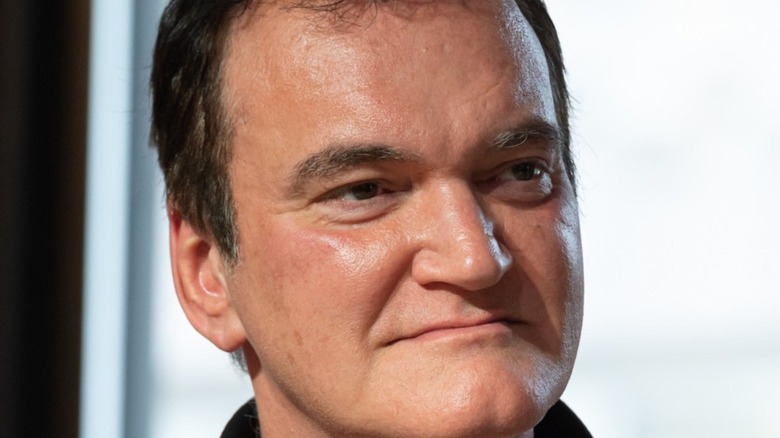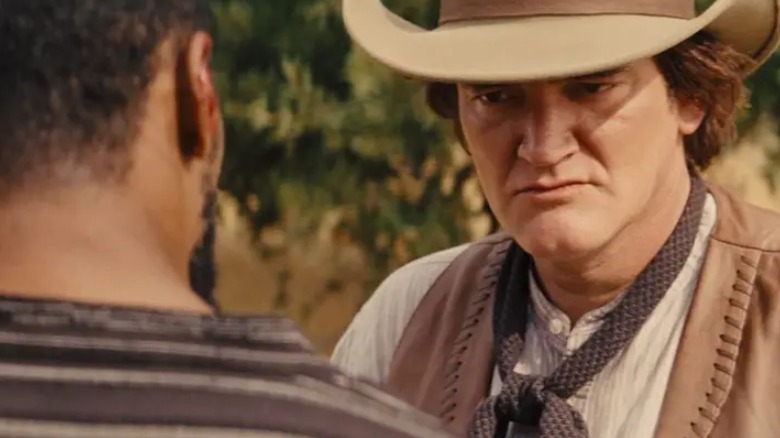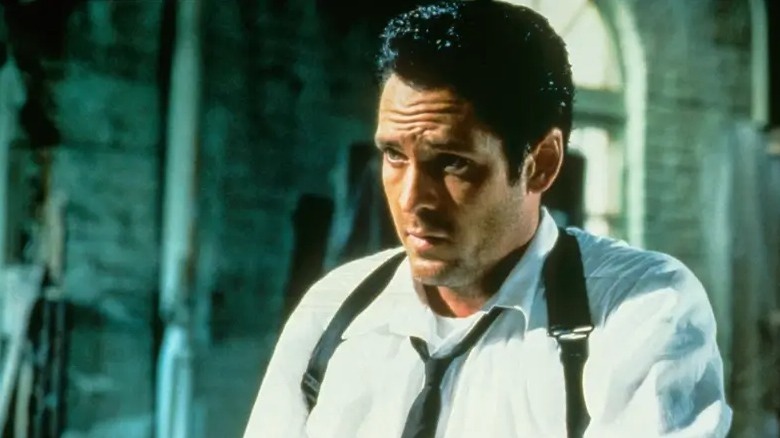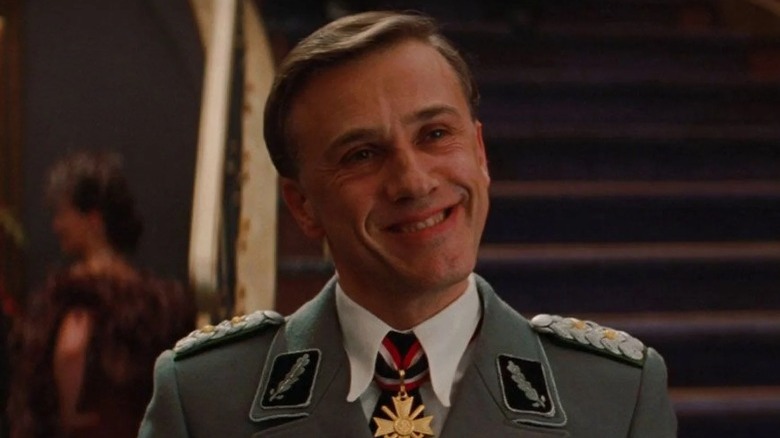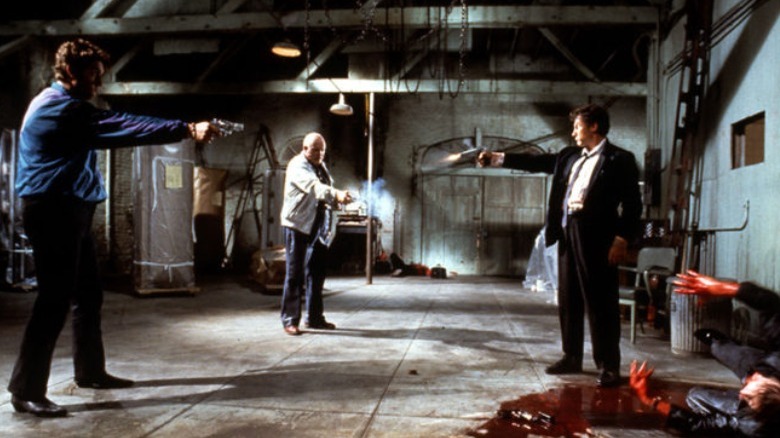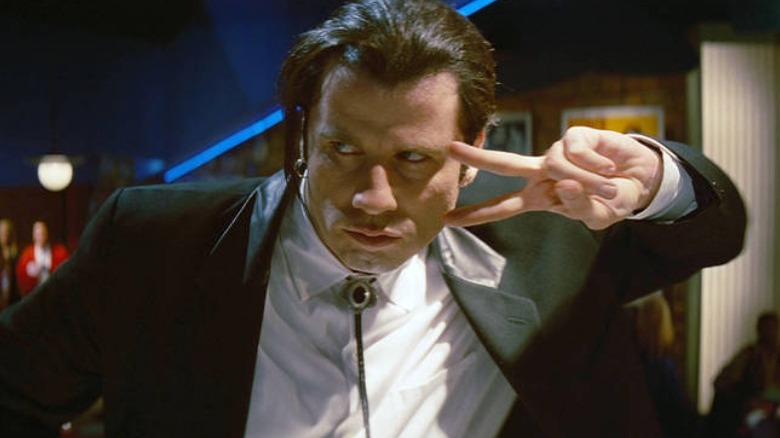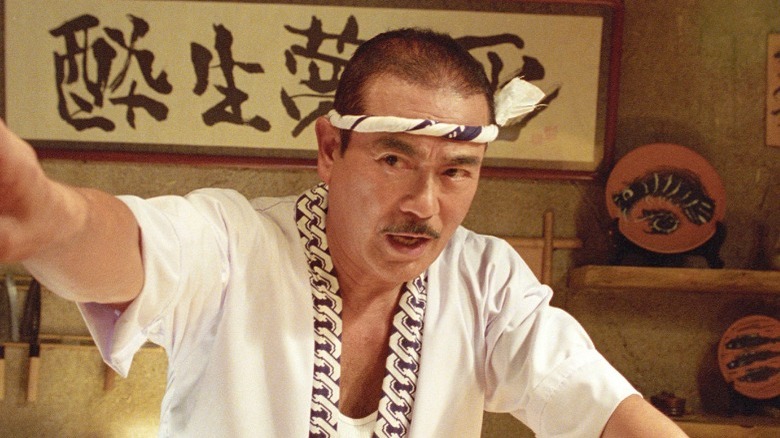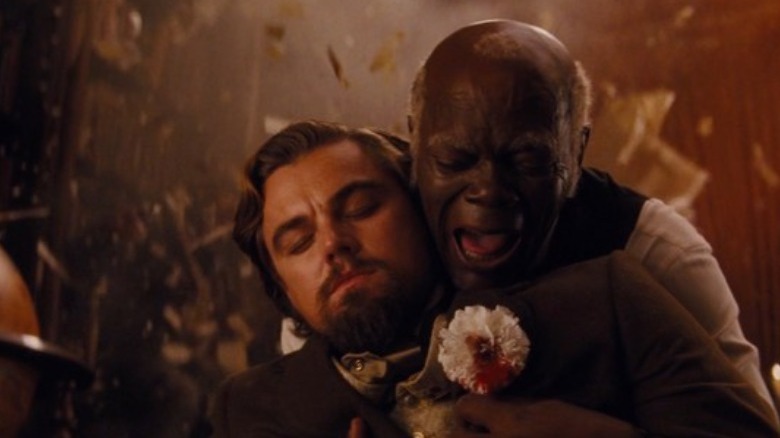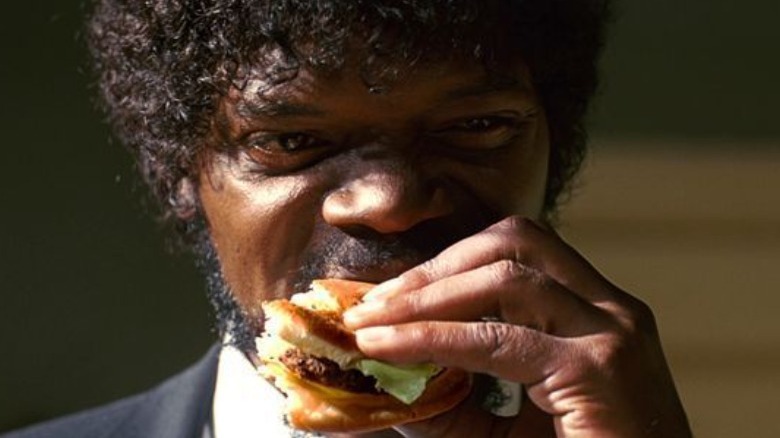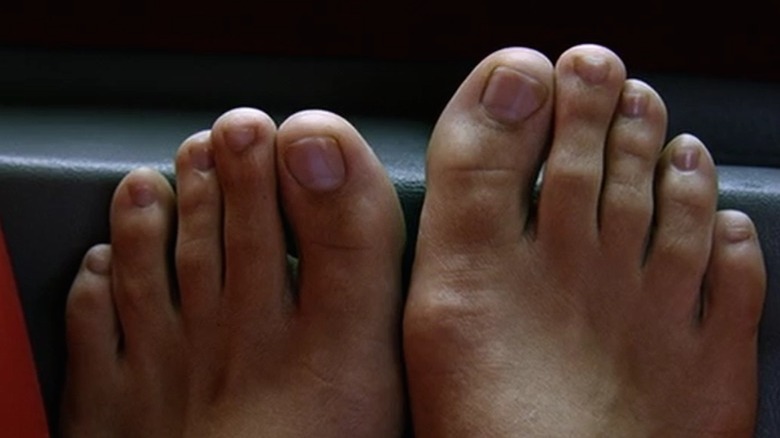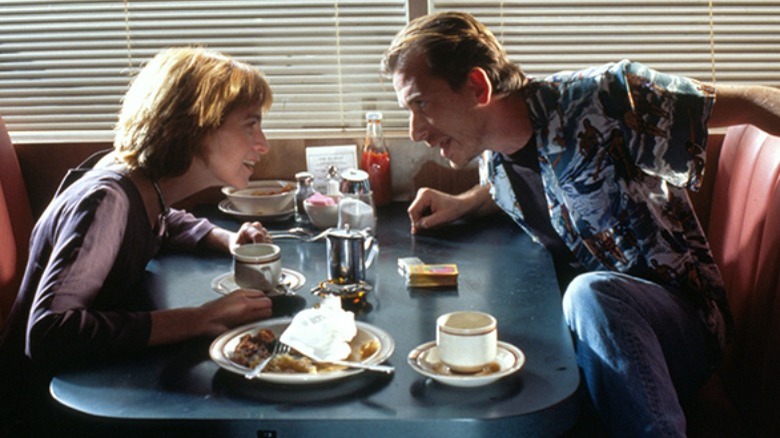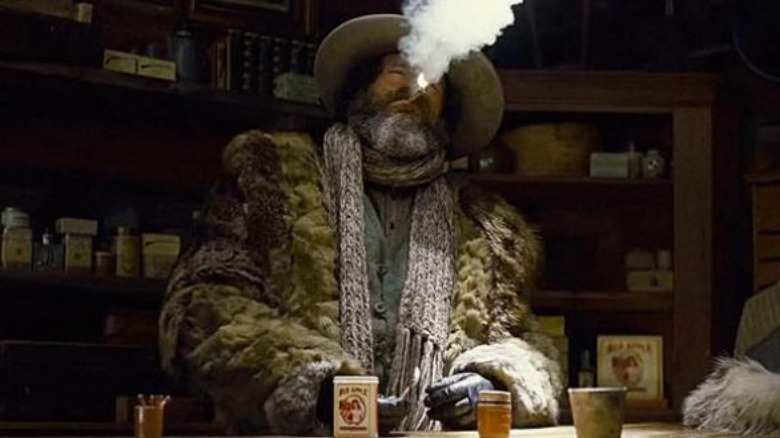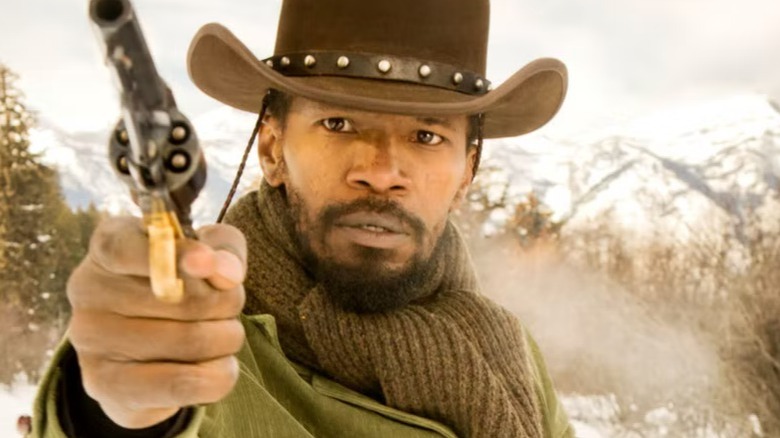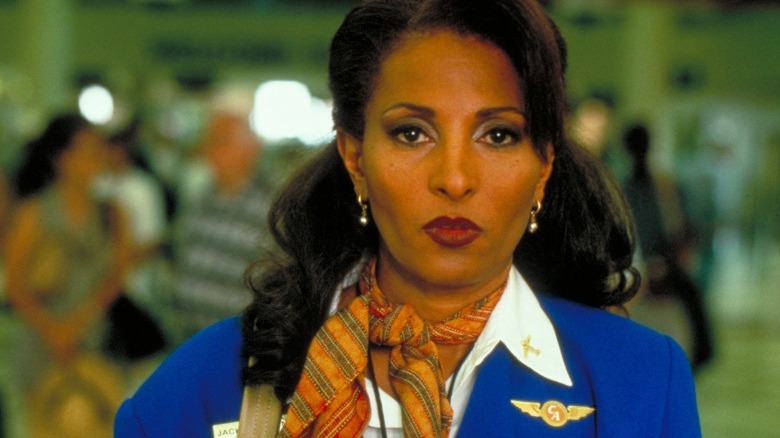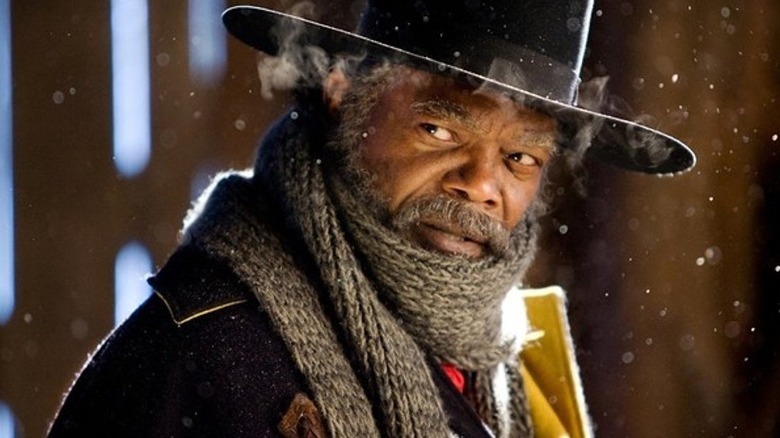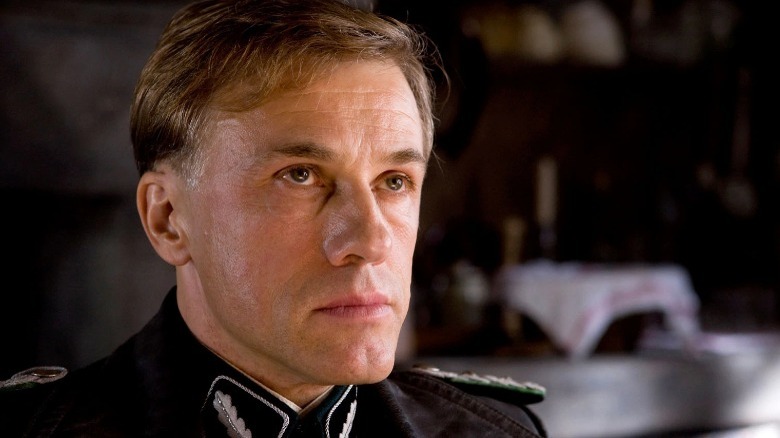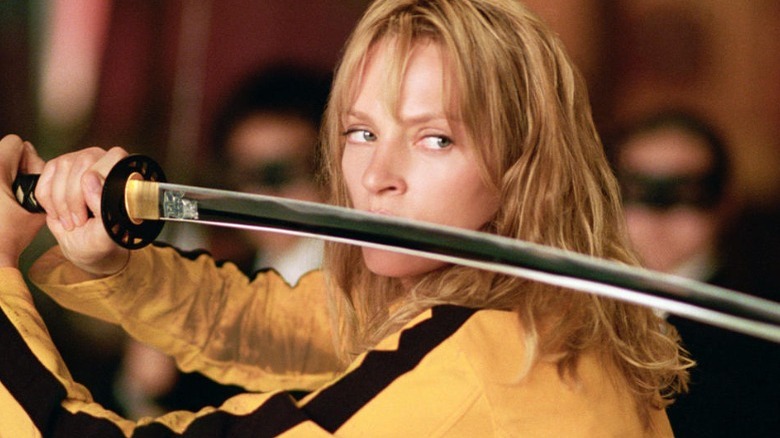Things That Happen In Every Quentin Tarantino Movie
Since he made his debut in 1992 with "Reservoir Dogs," Quentin Tarantino has become one of the most successful independent filmmakers in the world. Over the course of the last 30 years, he has released a string of critically acclaimed hits and won numerous awards, including the Academy Award for Best Original Screenplay twice.
Even his worst-received movies are still considered pretty decent and aren't that far behind in terms of the quality of his very best releases. One of the reasons for his consistency is that all his films share several qualities and characteristics. His back catalogue is certainly distinctive, and it's almost immediately clear you are watching a Tarantino film as soon as it starts due to the unique elements they share, from the stylish soundtracks to the intense dialogue.
What that ultimately means is that there are a lot of things that happen in every single Tarantino movie. You may well have noticed some of them and will likely be familiar with some of the more obvious similarities between them, but there are a few that you might not have realized.
Quentin Tarantino makes an appearance
Perhaps taking inspiration from the likes of Alfred Hitchcock, who made a habit of appearing in almost every project he directed (via Decider), Tarantino has a long tradition of making cameo appearances in his movies. This may well be due to the fact that the director also worked as an actor during his early career, as noted when he discussed his appearance in a 1988 episode of "The Golden Girls" while on "The Tonight Show Starring Jimmy Fallon." Spotting every cameo Tarantino makes has become something of a game for his fans, especially because some of them are harder to spot than others (via Insider).
There are some obvious examples, such as in "Reservoir Dogs" and "Pulp Fiction," where the director appears as significant characters. However, he has also had some more minor parts, including narrating the action in "The Hateful Eight" and playing the voice that can be heard as the robotic voice on an answering machine in "Jackie Brown."
Linking together all of his movies with hidden references
Almost all of Tarantino's have some sort of connection with each other, stronglysuggesting that they may well be all part of the same shared universe. A notable example is that Vic Vega from "Reservoir Dogs"—better known as Mr. Blonde—and Vincent Vega from "Pulp Fiction" are brothers. In fact, the director has even suggested a possible film featuring the two as the lead characters (via the Hollywood Reporter). Another instance comes when Um Thurman's character Mia Wallace explains to Vega in "Pulp Fiction" a television pilot she did that sounds very familiar to the plot of "Kill Bill."
Speaking to News.com.au in 2016, Tarantino revealed that all his films are either set in the same universe or are movies within movies. He explained that "the characters of 'Reservoir Dogs' or 'Pulp Fiction,' when they go to the movies, 'Kill Bill' is what they go to see. 'From Dusk Till Dawn' is what they see." That explains why some characters, like Pete Hicos and the "Inglourious Basterds" character Archie Hicox, are related, or why multiple products from across the various movies have the same name.
Seriously captivating villains
Villains in movies and other forms of entertainment tend to be rather abhorrent, vicious, and generally odious. This is necessary to get the audience to dislike them and encourage those watching to root for the good guys. Yet, Tarantino takes a different approach for his films, with most of the villains being good-natured and charming individuals who are just as captivating as any of the so-called heroes.
Take Jules from "Pulp Fiction" as a character to understand exactly what this entails. Despite being a hitman for a crime boss, he is polite, affable, and generally seems to be a nice guy, aside from all the murders. Another Samuel L. Jackson's character is the same, with Ordell Robbie in "Jackie Brown" possessing a likable quality. Bill from "Kill Bill" seems like a soft-spoken and almost grandfatherly figure but is, in reality, a remorseless killer, while the SS Colonel Hans Landa is one of the worst Nazis, yet his portrayal by Christopher Waltz makes him bleakly compelling.
Constant Mexican standoffs
Mexican standoffs are commonplace in certain types of film but for those unfamiliar with what they are, Merriam-Webster describes them as a situation where there is no clear winner and everyone is essentially trapped in a deadlock. Tarantino has been a particular fan of these types of events for almost as long as he has been making films.
Perhaps the most famous example comes in his first feature film "Reservoir Dogs," when Eddie, Joe, and Mr. White are all pointing guns at each other at the conclusion of the movie as they argue over whether Mr. Orange is the traitor. The situation ultimately ends with everyone involved being shot and mortally wounded.
This is far from the only time that Tarantino has used a Mexican standoff. The conclusion to "Pulp Fiction" features a similar moment, where Jules, Vincent, Ringo, and Yolanda all end up with guns aimed at them in the diner. Meanwhile, "Inglourious Basterds" sees Lieutenant Aldo Raine and Sergeant Wilhelm forced into a Mexican standoff while they try to negotiate the release of Bridget Von Hammersmark following a brutal shootout seconds before.
A unique musical soundtrack
One thing that you can be sure of in any Tarantino film is that the music will be distinctive and memorable. The director has explained in the past that the songs in his films set the entire tone for the experience and give a sense of the mood that viewers can expect (via No Film School). He carefully chooses records, mostly from his own collection, that he believes embody the spirit of the project.
Whether it's the torture scene in "Reservoir Dogs" where Mr. Blonde slices off the police officer's ear to the tune of "Stuck in the Middle With You" by Stealers Wheels, the Chuck Berry song "You Never Can Tell" in Pulp Fiction, or "Unchained (The Payback/Untouchable)" in "Django Unchained," audiences can expect to come away wowed by the soundtrack of any Tarantino movie as much as they are by the imagery and dialogue.
The director includes references to classic movies he is a fan of
Tarantino is a self-confessed cinephile and a student of film history. The director even has his own podcast, "The Video Archives Podcast," where he discusses classic movies. So it makes a lot of sense that he likes to include references to older films in his work—something that he does regularly.
According to Far Out Magazine, Tarantino is also a big admirer of Sonny Chiba and his martial arts movies. This is likely why he was included as part of the cast of "Kill Bill" in the role of legendary swordsmith Hattori Hanzō. Similarly, Bruce Dern has made appearances in "The HAteful Eight" and "Once Upon a Time in Hollywood" as the director is a fan of his appearances in classic films.
A blink-and-you'll-miss-it moment in "Django Unchained" sees the eponymous hero meet a character named Amerigo Vessepi, who expresses familiarity with the name. This character is played by Franco Nero, a veteran screen actor who appeared in dozens of Spaghetti Westerns, including "Django" and "Django Strikes Again."
Someone unexpectedly dying
Along with some pretty gruesome violence and plenty of killings, Tarantino likes to include unexpected and downright shocking deaths that the viewer would never have predicted. In a few cases, the audience might have thought a particular character may die at some point but not at that moment or in the exact way that they did.
Perhaps the most well known death of this kind came in "Pulp Fiction" when Bruce Willis' character Butch shoots John Travolta's Vince as he emerges from the bathroom halfway through the movie. But there are plenty of other examples as well, ranging from Calvin Candie's sudden murder in "Django Unchained" by Dr. Schultz to Robert De Niro snapping and killing Bridget Fonda's character in "Jackie Brown."
Of course, you also have the likes of Marvin's death in the car when Vincent accidentally shoots him, again in "Pulp Fiction," and Budd's demise in "Kill Bill" when he is attacked by the snake. "Reservoir Dogs" features a similar scene, when Mr. Orange shoots Mr. Blonde before he can kill the kidnapped cop.
Important scenes when people are eating or drinking
While eating and drinking are everyday parts of our lives, they are actions that are rarely seen in movies because of how mundane they are and that it gets in the way of the rest of the scene. But that's not the case with Tarantino, who has made a habit of having important and shocking moments centered around the act of consuming food or drink.
The opening scene of "Reservoir Dogs" shows the main characters eating together in a diner and lasts for almost 10 minutes in total, as they discuss plans and argue over whether to leave a tip. "Pulp Fiction" includes an important moment when Vince and Jules visit the men who owe their boss money and eat their fast food before killing them. This is also an example of the Enemy Eats Your Lunch trope.
As noted by Studio Binder, other moments in films like "Kill Bill," "Death Proof," and "Django Unchained" all feature scenes that use food to propel the plot forward, establish characters, and help inform the audience.
Close-up shots of feet
As shown by this compilation by Honest Trailers and Screen Junkies, Tarantino has a fascination with feet in his movies. There's no shortage of lengthy shots that focus entirely on the bare feet of largely female characters in a huge proportion of his films. Instances include numerous examples in "Once Upon a Time in Hollywood" involving Margaret Qualley's character, Uma Thurman in almost every appearance she has made in a Tarantino movie, and in the film "From Dusk Till Dawn—which he co-wrote but was directed by Robert Rodriguez, Selma Hayek places her feet in his mouth.
This is something that the director has actually spoken about, possibly because it has been brought up to him so many times. Speaking to GQ, Tarantino said: "That's just good direction. Like, before me, the person foot fetishism was defined by was Luis Buñuel, another film director. And Hitchcock was accused of it and Sofia Coppola has been accused of it."
Nonlinear narratives
Like many of his contemporaries, Tarantino is a master of nonlinear storytelling. Almost all of his films feature some sort of disrupted narrative, with events not happening in strict chronological order. Take two of his earliest films, "Reservoir Dogs" and "Pulp Fiction," for example and you'll realize that the plots in both films are disjointed, jumping to different points in time in order to build up suspense and introduce characters from different perspectives. "Pulp Fiction" notably both begins and ends at the exact same moment.
"Kill Bill" is another notable example, with the deaths not shown in the order that Kiddo actually killed them, with the timeline constantly jumping around to give you more context to what is happening. In a similar manner, "The Hateful Eight" features a plot where eventat that take place before the movie starts are not shown to the audience until near the conclusion. Even movies that have a more linear structure still feature some anachronisms, such as in "Jackie Brown," when the money drop sequence is shown from three different points of view.
Fictional brands are featured heavily
Something that fans are likely to see in any Tarantino film is a fictional Hawaiian burger restaurant known as Big Kahuna Burger. In total, this property has made an appearance in some nine movies, including "Reservoir Dogs" and "Death Proof," although it is perhaps best remembered from "Pulp Fiction" when Vincent and Jules burst in on the young men eating fast food from Big Kahuna Burger. But this isn't the only fictional brand that is a constant presence in the director's movies.
Perhaps the best example of this is Red Apple Cigarettes, a tobacco brand that has appeared in almost a dozen films that Tarantino has been involved in. Characters can be seen smoking cigarettes or holding packets at various points in "Pulp Fiction," "Kill Bill," "Death Proof" and "The Hateful Eight." They have even appeared in "From Dusk Till Dawn" and "Four Rooms" in addition to having a fully-fledged commercial centered around them in "Once Upon a Time in Hollywood" as Rick Dalton tries to promote the brand.
Over-the-top violence
From the moment that Tarantino started making movies, he's been drawn to including graphic violence as a key element. In interviews regarding this trend within his films, he has explained that essentially he finds violent scenes and action to be fun, claiming that it makes good cinema (via Screen Rant). He has also been dismissive of any potential link between real-life violence and the content of his films, suggesting he includes such content purely to entertain his audience.
If you've seen any Tarantino film, then you'll know exactly what kind of stylish violence he likes to include. "Reservoir Dogs" includes a horrific torture scene, "Django Unchained" has moments of intense gore in fights and shootouts, and "Kill Bill" has a scene where Kiddo maims and kills dozens of assailants. While it is often brutal, these sequences can also provide dark comedy moments, such as when Vince shoots Marvin in the car by mistake in "Pulp Fiction."
A return for past film stars
Tarantino has been responsible for launching the careers of certain actors, or at least giving them their big breakthrough. You can look at Melanie Laurent in "Inglourious Basterds," Tim Roth in "Reservoir Dogs," and Samuel L. Jackson in "Pulp Fiction" as good examples. But the director has also developed a reputation for bringing back once great movie stars who had seen their flame diminish over time.
Tarantino's movies have frequently featured movies are actors who have been given the chance to regain some of their former glory. David Carradine was a martial arts expert and action star in the 1970s but was reduced to appearing in straight-to-video movies before his role in "Kill Bill" (via The Independent). Both Pam Grier and Robert Forster watched their careers dip until they were cast in lead roles for "Jackie Brown" (via Variety). Even John Travolta's inclusion in "Pulp Fiction" raised eyebrows, especially as producers wanted Daniel Day-Lewis for the role but it revitalized his career once he accepted (via Vanity Fair).
The same familiar faces will show up
Although we've discussed how Tarantino likes to give old and new actors their chance to shine, he also tends to work with a select few collaborators regularly. Maybe he just gets one with these people really well or they are willing to stick to his list of demands for actors. The most famous of these is Samuel L. Jackson, with the actor appearing in six of the director's nine projects, spanning years of collaboration in projects like "Pulp Fiction" and "The Hateful Eight."
He has also worked extensively with actor and stunt woman Zoë Bell, who has credits in every one of his films since "Kill Bill." Meanwhile, Leonardo DiCaprio has appeared in two of his last three films, Uma Thurman has two leading roles in "Pulp Fiction" and "Kill Bill," and Christoph Waltz was chosen as a supporting member of the cast for "Inglourious Basterds" and "Django Unchained." Veteran actors Michael Madsen and Tim Roth have also worked frequently with the director, appearing in nine of his movies between them.
A lengthy monologue from one of the characters
Tarantino's movies are known for being dialogue heavy and he uses it to great effect in a number of monologues that are scattered throughout all of his releases. While many people will remember a Tarantino flick for the intense action or distinctive soundtracks, they'll also likely come away thinking about the memorable speeches given by some of his characters.
"Pulp Fiction" is a film that contains several brilliant monologues. Whether it's the gold watch segment delivered by Christopher Walken or the biblical verse recited by Samuel L. Jackson, anyone who has seen these films will have these scenes seared into their brains. Likewise, Leonardo DiCaprio's furious tirade in "Django Unchained" ups the tension dramatically, while Kiddo's recap of the first "Kill Bill" film in the sequel drives home the damage done to and by her throughout the narrative.
There's also Tarantino's favorite monologue from his career: specifically, the one given at the beginning of "Inglourious Basterds" by Hans Landa (via Far Out Magazine). In it, he speaks to a dairy farmer about the Jewish refugees the French man is hiding... and quickly establishes just how evil he is.
Strong, action-oriented women
Tarantino has been hailed by some for the work he has done in portraying women in his films. Unlike many other movies, which relegate female characters to little minor roles or as damsels in distress, the director has made a point to include powerful, determined, and strong women in many of his releases (via The Guardian). "Kill Bill" is a great example of this, with the main character Beatrix Kiddo an butt-kicking hero who is capable of fighting off entire armies of enemies and holding her own against male characters (via Far Out Magazine). Most of the female characters in the "Kill Bill" films are strong and assertive, even if they are eventually defeated by Kiddo.
However, this trope extends into other movies from the director as well. The titular character in "Jackie Brown" is the brains behind the operation and ultimately manages to outsmart every one of the male characters who think they can control her. Additionally, the women in "Death Proof" not only manage to escape from the killer played by Kurt Russell, but manage to hunt him down and kill him for what he has done.
